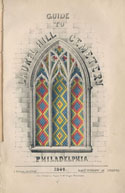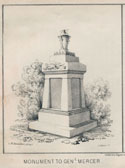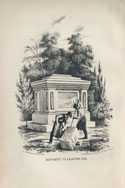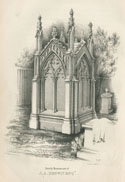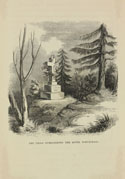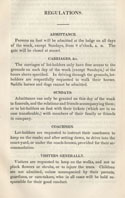Touring
Americans loved rural cemeteries. Before the Civil War and the advent of large urban parks, an afternoon spent among the tombs struck many as the ideal form of leisure. Visitors arrived at Laurel Hill by horseback, carriage, and steamboat. Horse-drawn streetcars rolled up Ridge Avenue by the late 1850s. But at what point did mass visitation begin to undermine the “rural” ideal? As cemetery managers pondered that question, they devised new regulations and restrictions.
Laurent Deroy, lithographer. Laurel-Hill Cemetery. New York: Goupil, Vibert & Co., 1848.
The oblique approach to Laurel Hill along Ford Road (roughly today’s Clearfield Street) offered the kinds of views connoisseurs of the “picturesque” appreciated.
Laurel Hill Cemetery Gate, Philadelphia (ca. 1840). On loan from the Pennsylvania Academy of the Fine Arts. Gift of Mrs. Edgar P. Richardson.
John Notman. “Ground Plan of Laurel Hill Cemetery,” from Guide to Laurel Hill Cemetery (1844). Laurel Hill Cemetery.
Monuments in Laurel Hill Cemetery, from Guide to Laurel Hill Cemetery (1844).
Against the homogenizing spread of obelisks, Smith drew visitors’ attention to complex, custom-made designs shaped by history, biography, and sentiment. John Notman’s Gothic tomb for John A. Brown bespoke family cohesion. The Egyptian sarcophagus of Joseph Lewis (also by Notman) used a bas-relief of the Waterworks to recall the deceased’s role in that project. Scabbard and cannon announced Mercer as a war hero. And, near the end of the recommended tour route, visitors were told to look for “a stone cross, partially covered with vines, on a point of rock.” This scene exemplified the fusion of Christianity and nature worship that pervaded the cemetery as a whole.
Regulations of the Laurel Hill Cemetery on the River Schuylkill near Philadelphia. Philadelphia: John C. Clark, 1839.
Laurel Hill’s printed rules grew more elaborate over time. Sunday access had initially been limited to funeral goers and lot-holders with company tickets. After 1847, visitors planning to arrive on other days needed tickets, too. Smith distributed these from his office at the Library Company and Frederick Brown from his drug store on Chestnut Street.
Visitor log book from Laurel Hill Cemetery (1848). Laurel Hill Cemetery.
John Jay Smith estimated that “nearly 30,000 persons ... entered the gates between April and December, 1848.” (Others were kept at bay; two “stalwart men” were hired for the purpose.) This logbook evidently served as the basis for Smith’s claim. However, as signatures like that of “Breaky Hardass” suggest, decorum was hard to maintain.


